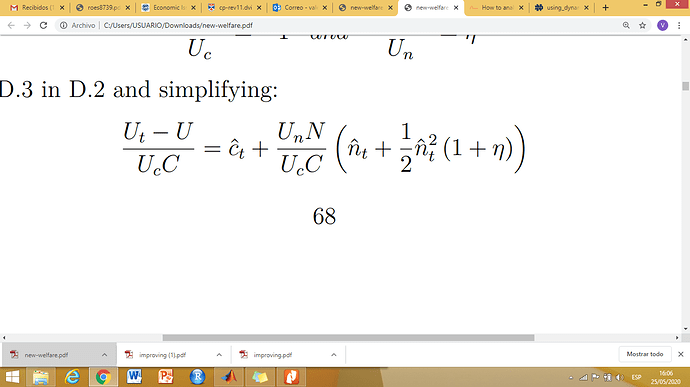Dear all,
I established a logarithmic linearization model. I want to analyze the welfare loss function,like
lambda_x *var(y_hat)+var(pi_hat). Can someone tell me how to do it? If there is an example, it is best.
What exactly do you want? If you already derived your linear-quadratic model, then you can simply plug in the numbers. See for example
excuse me, professor, I want to know why the wealfare loss function (like line 316 in your code) shall be divided by 100? Thank you!
Because it is expressed in percent so that 0.01 is one percent. The reason is that we are dealing with a linear model where a standard deviation of 1 for the shocks has been used to mean 1 percent. One needs to undo this to match the numbers in the book. A more thorough way would be to use 0.01 as the shock standard deviation and not divide welfare by 100.
Dear Professor. I have a follow up question on this topic.
How can I use this example to do welfare analysis using a nonlinear model (such as Gali_2015_chapter_3_nonlinear.mod )? Can use the same definition of natural output and interest rate and add them to the model block? Do I need to change anything in the Loss Function?
Thank you very much for your patience. I really appreciate it.
Dear professor,
I need to compute the welfare: W=U+BETA*W(+1), but I am using a linear model. Do you know how can I do it?
I computed already the central bank loss function. I attach my code,
Many, many thanks in advance!
[linear quadratic welfare.mod.txt|attachment]simple welfare analysis.mod.txt (7.4 KB)
That is not easily possible. A linear model will not contain the required information like the constants for a full welfare analysis. But of course you can do a quadratic approximation to utility.
Thanks a lot for your reply professor, you mean a kind of a central bank loss function in terms of output gap and inflation?
No, not necessarily. You could approximate utility in its arguments.
Thanks a lot professor, in the end I get a linear quadratic approximation that includes terms at the steady state in terms of consumption and labor, how should I implement these steady state terms (as part of the function) in dynare?
Thanks in advance!
There are two ways:
- You can drop the steady state as it should be the same for all parameter values.
- You need to specify the steady state of the nonlinear model as parameters of your linearized model. Of course, then you have to compute them.
Hi, I had a question regarding the calculation of the conditional welfare function eg (W=U+BETA*W(+1)).
If you have a loss function (U) with 3rd order terms, would it be possible to solve the model to a third order and the zero out all rows in oo_.dr.g_3 that relate to all other variables to solve the rest of the model to the second (or first) order?
Thus the core of the model is solved to a 1 or 2 order approximation, while we track the loss function to the third order?
I cannot answer that question in general. We know that linear-quadratic approaches are only valid under particular conditions. The same should apply here if you move everything up by one order.
Dear professor,
Thanks for your reply, what do you mean by “drop the steady state”? My model is linear, and at the end I get the term u_nN/U_c C, as in the figure below, should I just cancel it out?
I see. You need the steady state for the deviation part. Then you cannot drop it. You need to compute it.
